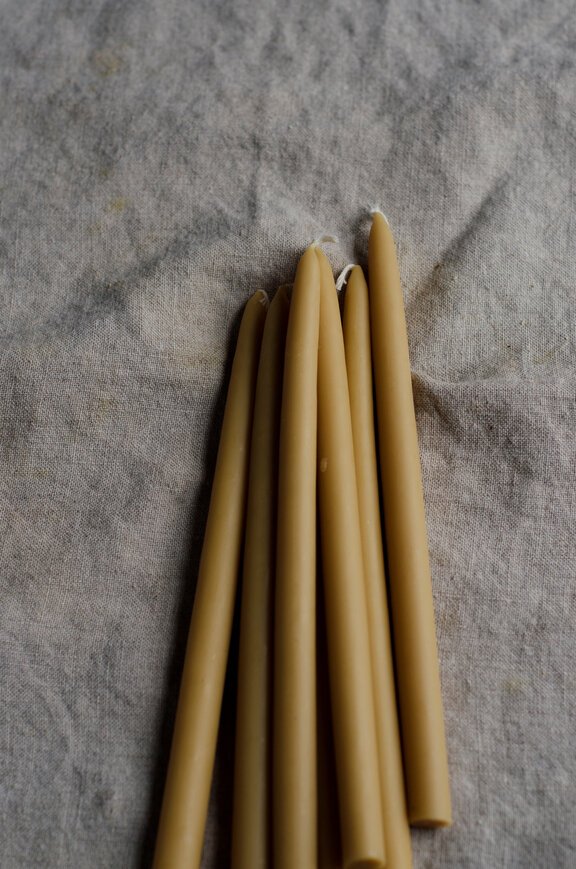
How To Make Candles At Home, According To A Chandler
DIY Candles to Warm Up Your Winter 🕯️
I recently learned how to make my own candles. With winter in full swing, it’s peak candle burning season at my place, and I like to have at least one lit throughout most of the day. I find it adds light and warmth to my home. And in 2020, we’ve got to cling to the things that bring us joy, right?
While I still enjoy buying small-batch candles (here are our favorite nontoxic brands), I’ve also learned it’s much more cost-effective (and fun) to make them in the comfort of my kitchen. It’s also fairly easy, though achieving the perfect pour does require a few tips and tricks.
Cue Tashah Nicole, the founder of Candlessentials. Her small batch candle company based in Southern California specializes in coconut wax candles that come in plantable packaging. (Really!) I recently reached out to her for expert chandler advice, and she shares her knowledge below. I have a feeling with her advice, we can all be expert candle makers by this winter!
Whether you’re looking for a new hobby or you want to make gifts for family and friends this year, here’s everything you need to know to make your first batch of candles at home.
— Part One: Gather Your Supplies —
To make candles at home, you’ll need to invest in a few supplies. I recommend shopping secondhand for things like a pouring pot and thermometer (eBay is great for this). For wax and wicks, I’ve found it to be about trial and error. Besides finding companies that align with your values and needs (e.g., vegan wicks, paraffin-free wax), you may discover that you like working with soy versus coconut wax or cotton wicks over wooden ones. I recommend keeping an open mind and trying a few different companies before settling on one you love.
Alternatively, you can buy a simple candle-making kit like this one from The Baltic Club. It includes almost everything you need to make your first batch.
Wax
“There are a lot of suppliers of candle wax here in the US, but only a few manufacturers,” says Tashah. According to her, you’ll want to confirm with the supplier that they are sourcing from a reputable manufacturer and that the wax doesn’t have unnecessary additives or blends. Not all of this information is always listed online, so it’s best to reach out via phone or email before purchasing.
“Confirm with the supplier that they are sourcing from a reputable manufacturer and that the wax doesn’t have unnecessary additives.”
When it comes to choosing your wax, Tashah recommends either coconut or soy wax. “Coconut wax is a more renewable source, which is one reason it’s become so popular in the last few years. It’s also a lot easier to use in the candle making process. Soy wax is a bit more volatile and takes patience, but both yield beautiful candle experiences,” she says. The Flaming Candle sells both coconut and soy wax in 2, 5, 10, 20, and even 60-pound slab blocks.
Wicks (and Wick Holders)
Next, you’ll need wicks, as well as wick holders. “Cotton, wood, and hemp wicks are all great options,” says Tashah, though she notes that the wick you want will really depend on your goal with candle-making.
“Cotton, wood, and hemp wicks are all great options.”
Wooden wicks, for example, are easy to place using a wick clip as they don’t require additional support while the wax is hardening. They can create a more even burn because of the lower temperature, and the fragrance tends to last longer than with other wick options. It’s generally much easier to trace sustainability with wooden wicks as well. However, you’ll want to ask suppliers where they sourced the wood and if they use accelerants (for flame retention) or glue (for multi-ply wicks).
Alternatively, cotton wicks are versatile, affordable, and make for easy burning. Because they can be more difficult to place while the wax settles, I personally recommend the pencil trick. Unfortunately, most cotton wicks are dipped in paraffin (a petroleum byproduct), lead, and zinc, and it can be challenging to find sustainable options. For affordable, unprimed cotton wicks, I recommend Waxing Moonshine on Etsy.
Hemp wicks are a third option, and they’re likely the most sustainable. Most hemp wicks are dipped in beeswax, so if you’re looking for a vegan alternative, I recommend this handmade and organic wick. I love that you can purchase it on a spool or pre-tabbed (meaning it’s prepped and ready to place in the candle container).
For even more information about wicks and an in-depth comparison between wood and cotton, this article from Darling Candles is a wonderful resource.
Fragrance (Optional)
I personally don’t use fragrances when making candles at home. I’m sensitive to smells and prefer candles for their ambiance and warmth. Fragrances can also be challenging because they need to be specifically formulated for candles to bond with the wax (and for safety purposes).
“Fragrances need to be specifically formulated for candles to bond with the wax (and for safety purposes).”
But if you want to add natural fragrances to your candles, you can use natural blends or essential oils specific to candles, like the Cypress & Fig and Honey Fig & Ginger oils from The Baltic Club. The Wooden Wick also sells pure and undiluted essential oils for candles, including cedarwood, blood orange, and lavender.
Tashah recommends doing extensive research before adding any fragrances to your candles and notes that many oils aren’t sourced sustainably. “A large number of essential oils become toxic when heated,” she adds. This can be especially important if you have pets at home. Certain oils are toxic at high temperatures, so be sure to consult research and manufacturers before adding them to your candle blends.
Additionally, and especially if you are making candles to give to family or friends, you’ll want to conduct a burn test to ensure safety.
Supplies
Last up, you need candle-making supplies! This will include a pouring pot, a large pot for boiling water, a glass or meat thermometer, and your candle containers. You can use almost anything for these! I like reusing old candle containers as well as glass jars. Just make sure whatever you’re using is thick and heat-resistant.
— Part Two: Make Your Candles! —
Making candles at home is really easy. The majority of companies are going to send you step-by-step instructions with their wax and wicks. Many of these companies also offer instructions on their websites, so it’s easy to follow along as you melt and pour your first batch.
You’ll find that companies have varying recommendations regarding temperature and pour points (it will be different depending on your wax, too). This is why it’s best to consult those specific instructions instead of following a generic guide. As you become more experienced, you’ll be able to make your own adjustments as well. Candle making, as I’ve mentioned, is very much about trial and error.
But to give you an idea of the process (and how simple it is!), here are the general steps for making candles at home:
1. Prep your containers
Tashah recommends making 8 oz. candles when starting out, as they’re the most popular. You can use upcycled jars; just make sure they’re clean and dry. I like to set mine out on an old rag in case of spills or splatters. Keep in my mind, you won’t want to move your candles after you pour the wax in, so place them somewhere where they can sit overnight without being disturbed. This is also when to place your wicks using your wick holders.
“You won’t want to move your candles after you pour the wax in, so place them somewhere where they can sit overnight.”
2. Melt your wax
Use your pour container and pot of water (about half full) to create a double boiler. Follow the manufacturer’s instructions for this step—this will include how to measure out your wax along with the temperatures you’ll want to watch for. (Time for that thermometer!) The pouring point is generally between 120 and 140 degrees F for soy container candles.
If you’re more of a visual learner, I’ve found this video guide from Bramble Berry to be helpful, especially for my first pour.
3. Pour the candles
Now for the fun part—pouring your candles! For this step, what’s most important (aside from safety) is ensuring your wick stays in place. It can be more challenging with cotton wicks, so I strongly recommend wick holders or the pencil method mentioned above (linking again). If you have a roommate or partner at home, another pair of hands works, too. Pour your wax until it almost reaches the rim of the container—it will settle a bit when it cools. To get a smooth candle-top, you may need to do a second pour once the first layer solidifies. For this, you’ll simply reheat leftover wax and top off of the container.
And that’s it! Really. Once you’ve poured the wax into your containers, all that’s left to do is wait. It’s best to allow your candles to cool overnight, though—size and temperature depending—you’ll see the wax beginning to harden within a few hours.
It’s going to take time to perfect your candle-making process, but it’s totally worth it. You may, for example, notice tunneling or cracking in the first few batches. But, as Tashah explains, it just comes back to lots of testing, especially with wicks. “This is the most extensive part of candle making,” she says. “Test your oils and wicks, and then test again!”
And have patience. Do your best not to rush the process, encourages Tashah. “Once you land on the perfect wax, oil, and wick combination, it’ll all be worth it!”
“Once you land on the perfect wax, oil, and wick combination, it’ll all be worth it!”
Finally, consider joining a candle making support group online through platforms like Reddit or Facebook. Tashah says they are great for helping to bypass simple rookie mistakes. Especially during COVID, online groups are a wonderful resource, specifically for community—something we can all benefit from during the winter months.
Wishing you warmth and light in your candle making! ✨
What are your favorite DIY crafts to make at home? 🕯️ Share in the comments below!
RELATED READING
Kayti Christian (she/her) is an Editor at The Good Trade. She has a Master’s in Nonfiction Writing from the University of London and is the creator of Feelings Not Aside, a newsletter for enneagram 4s and other sensitive-identifying people. Outside of writing, she loves hiking, reading memoir, and the Oxford comma.

